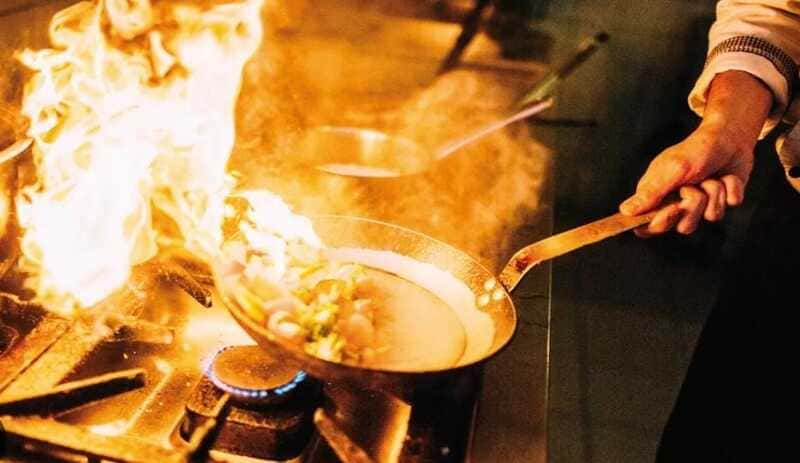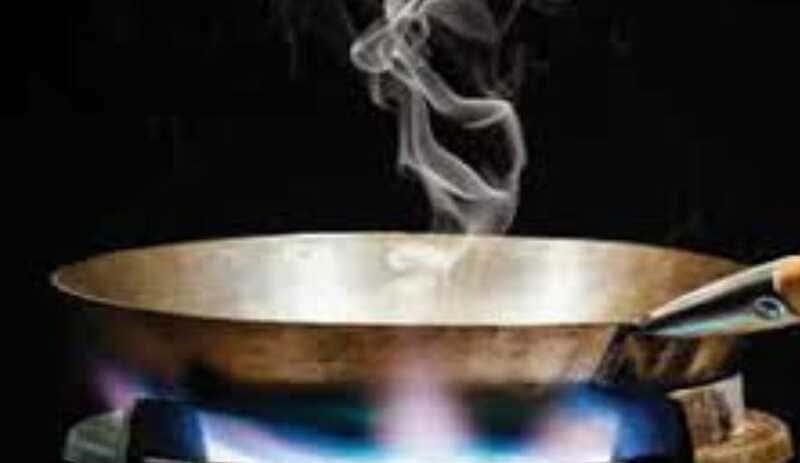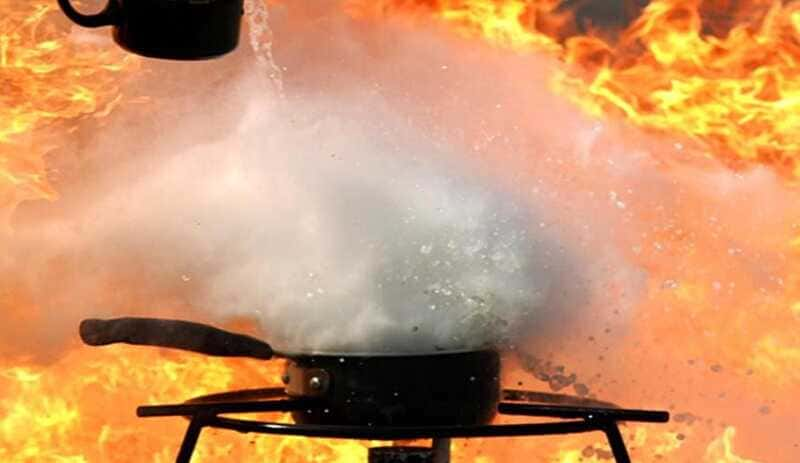The kitchen is the heart of the home, a place where delicious dishes are prepared to delight our loved ones. However, it is also one of the most fire-prone scenarios, especially when it comes to oil fires. A simple carelessness or mistake in handling hot oil can trigger a dangerous and potentially catastrophic situation.
In this article, we will provide you with vital information and practical tips on how to stop an oil fire in the kitchen. You will learn about the common causes of these fires, how to prevent them and, most importantly, how to act effectively if you are faced with this emergency.

Whether you’re an experienced chef or simply enjoy cooking at home, knowing the proper safety precautions and being prepared to act in the event of an oil fire can make the difference between a scare and a tragedy. So, let’s dive into the world of kitchen safety and discover how to protect ourselves, our loved ones and our home from the dangers of an oil fire in the kitchen.
Introduction to oil fires.
The kitchen, that place where tantalizing aromas and culinary creativity converge, can become a scene of danger in a matter of seconds. One of the most common kitchen hazards is an oil fire, a threat that can quickly ignite and prove catastrophic if proper measures are not taken.
But how do these oil fires occur in the kitchen and why are they so dangerous? To understand, it is crucial to know the fundamentals behind this type of emergency.
Oil, when heated to elevated temperatures, can reach its ignition point, that is, the point at which it ignites. This chemical reaction occurs due to the combination of three essential elements known as the “fire triangle”: fuel, oxygen and heat.
In the case of cooking oil fires, oil acts as the main fuel. Oxygen is abundantly present in the environment. And the heat needed to reach ignition temperature can come from an open flame, a hot cooking element or even a faulty electric heater.
Once the oil ignites, flames can spread rapidly due to its high temperature and the presence of flammable vapors. The fire can spread to other items in the kitchen, such as utensils, curtains or cabinets, increasing the risk of property damage and personal injury.
In this situation, it is essential to know how to stop an oil fire in the kitchen safely and effectively. A quick and appropriate response can make the difference between a controlled incident and a total disaster.
In the following sections of this article, we will explore various strategies and techniques for dealing with an oil fire in the kitchen. From prevention and proper handling of hot oil, to the necessary safety measures and the correct use of fire extinguishers, we will discover the key steps that will allow us to put out the fire without endangering our lives or the lives of our loved ones.
Remember, stopping an oil fire in the kitchen is a vital skill that everyone should possess. By being prepared and knowing how to act in case of an emergency, we can ensure safety in our home and enjoy cooking with peace of mind and confidence.
Kitchen safety.
Safety in the kitchen is a fundamental concern that we should all keep in mind when preparing our meals. It is not only about creating delicious dishes, but also about ensuring a safe and secure environment against potential emergencies, such as an oil fire.
Keeping the kitchen clean is one of the first steps toward safety. Make sure there is no debris, spilled food or grease buildup around appliances and on work surfaces. This will reduce the risk of accidental fires and allow you to work more safely.
Another essential aspect is to have a fire extinguisher in the kitchen. An adequate and well-maintained extinguisher can be the difference between controlling a fire in its early stages and allowing it to spread and cause significant damage. Make sure the extinguisher is easily accessible, in a visible location and that everyone in the family knows how to use it properly. This is especially relevant when dealing with an oil fire in the kitchen.
Knowing the emergency exits is also vital. You should be familiar with the escape routes available in the event of a fire or other emergency. Identify the nearest exits and make sure they are clear and free of obstructions. In addition, it is important that everyone in the home knows how to access these exits quickly and safely.
Now, back to the main topic, how do you stop an oil fire in the kitchen? It’s crucial to remember that putting out an oil fire incorrectly can make the situation worse and jeopardize your safety. Never try to put out the fire with water, as this can cause a violent reaction and spread the fire even further.
Instead, remember to apply the basic rule of “smother, don’t water”. Use a tight-fitting lid or a large baking sheet to cover the burning pan or pot. By depriving the fire of oxygen, you will reduce its intensity and effectively extinguish it. Don’t forget to turn off the burner or disconnect the heat source before attempting to cover the fire.
Correct choice of cooking oil.
The right choice of cooking oil plays a critical role in the safety of our cooking. Often, we underestimate the importance of using proper and safe oils, not realizing that this can make the difference between an out-of-control fire and a smooth cooking experience.
One of the key characteristics to consider when selecting a cooking oil is its smoke point. The smoke point refers to the temperature at which an oil begins to break down and emit smoke. It is at this point that the oil can ignite and start a fire.

Using oils with high smoke points is essential to prevent them from catching fire easily during cooking. Oils with low smoke points, such as extra virgin olive oil, may be suitable for cold dressings or sauces, but are not ideal for frying or cooking at high temperatures.
Oils with higher smoke points, such as canola, sunflower or corn oil, are safer choices for preparations involving intense heat. These oils have greater stability at high temperatures, which means they will take longer to reach their smoke point and are therefore less likely to ignite.
In addition, it is essential to maintain constant attention when cooking with hot oil. You should never leave the kitchen unattended while you are frying or heating oil. Simple carelessness can have disastrous consequences. Always keep a close eye on the pan and, if necessary, reduce the temperature to prevent the oil from reaching its smoking point.
In the event of an oil fire in the kitchen, knowing how to stop it properly is essential. Remember to never try to put out the fire with water, as this will only make the situation worse and increase the risk of the fire spreading. Instead, turn off the burner or remove the heat source and cover the pan with a tight-fitting lid or large baking sheet to deprive the fire of oxygen.
Oil temperature and control.
Proper control of oil temperature during cooking is essential to avoid incidents in the kitchen, especially oil fires. Understanding how to manage and regulate oil temperature is essential to ensure safety in our culinary preparations.
First, it is important to choose the correct temperature based on the recipe and the type of food being cooked. Each ingredient has specific temperature requirements to obtain the best results. When heating oil, we must be sure not to exceed its smoke point, i.e., the temperature at which the oil begins to break down and emit smoke. Exceeding this point can cause a fire.
To control the temperature of the oil, it is advisable to use a cooking thermometer. This will allow us to accurately monitor the temperature and adjust it as necessary. Placing the thermometer in the pan or pot before heating the oil will help us to maintain constant control and prevent the temperature from rising too high.
If the oil begins to smoke or burn, it is crucial to act quickly and safely. An oil that reaches its smoking point is a clear sign that it is about to ignite. In this situation, it is vital to remain calm and follow the proper steps to stop an oil fire in the kitchen.
The first thing you should do is turn off the burner or disconnect the heat source. Do not try to move the pan or pot, as this can cause the oil to spill and spread further. Cover the pan or pot with a tight-fitting lid or large baking sheet to smother the fire, depriving it of oxygen and reducing its intensity. Never try to put out the fire with water, as this will only make the situation worse.
Once the fire has been extinguished, it is important to assess the situation with caution and ensure that there is no risk of reignition. Remain vigilant and make sure the area is completely safe before continuing to cook or clean.
How to prevent an oil fire.
Another fundamental issue in the process of how to stop an oil fire in the kitchen is to prevent it from occurring. Preventing an oil fire in the kitchen is vitally important to ensure the safety of our home and those who live in it. Fortunately, there are simple but effective preventative measures we can take to significantly reduce the risk of such an incident occurring.
The first key tip is to avoid overheating the oil. Before you start cooking, make sure you select the right oil for the task and set the correct temperature according to the recipe. Heating the oil to an excessively high temperature can cause it to quickly reach its smoke point and ignite. Monitoring the temperature of the oil using a cooking thermometer is a reliable way to ensure that it does not exceed its safe limit.
In addition, it is critical to never leave the kitchen unattended while cooking with oil. Simple carelessness or distraction can have serious consequences. Keep a constant watch over the pan or pot containing the hot oil and make sure you are present on the stove at all times. If you need to leave the kitchen for any reason, turn off the burner and remove the pan or pot from the heat.
A common but dangerous mistake is to add water to hot oil. This combination can provoke a violent reaction and cause the oil to spatter or catch fire instantly. Never, under any circumstances, attempt to put out an oil fire with water. Instead, turn off the burner, cover the pan or pot with a tight-fitting lid or large baking sheet to smother the fire and deprive it of oxygen.

Remember, preventing an oil fire in the kitchen is much more effective and safer than having to stop it once it has occurred. Adopting simple but consistent safety habits, such as not overheating oil, not leaving the stove unattended while cooking with oil, and never adding water to hot oil, can make a big difference in protecting our kitchen and our lives.
What to do in case of an oil fire.
In the event of an oil fire in the kitchen, it is critical to act quickly and safely to minimize damage and protect those present. While these situations can be frightening, following the proper steps can make the difference between a controlled fire and an uncontrolled emergency. Here are the steps to follow in the event of an oil fire.
First and foremost, stay calm. Keeping a cool head will allow you to make better decisions and act effectively. Do not panic or try to quickly move the burning pan or pot, as this could cause the oil to spill and make the situation worse.
First, turn off the burner or remove the heat source. This will stop the heat supply to the oil and prevent the flames from intensifying. Remember never to try to move the fire into a sink or basin, as the water may cause a violent reaction and spread the fire even further.
Once you’ve put out the heat, it’s time to smother the flames. Use a tight-fitting lid to cover the burning pan or pot. If you don’t have a lid handy, you can use a large baking sheet to cover the fire. By doing so, you will deprive the fire of oxygen, which will help extinguish the flames. Never try to put out an oil fire with water, as this will only make the situation worse and may cause the oil to spread and the fire to spread.
Once the fire is out, it is important to assess the situation and make sure there is no risk of reignition. Remain alert and watch for any signs that the flames may reignite. If necessary, keep the pan or pot covered until you are sure the fire is completely extinguished.
Use of fire extinguishers.
Fire extinguishers are vital tools for fighting and controlling fires, including those involving an oil fire in the kitchen. In the event of an emergency, knowing how to use a fire extinguisher properly can make the difference between a dangerous situation and a controlled fire. It is essential to understand how it works and follow the correct steps for effective use.

Before dealing with a fire, it is important to know the different types of extinguishers and which type is appropriate for an oil fire. For oil fires in the kitchen, Class K extinguishers, specifically designed for grease and oil fires, are recommended. Make sure you have a Class K extinguisher in the kitchen near areas prone to cooking with oil, such as the stove or fryer.
When an oil fire occurs, follow these steps to use the extinguisher effectively:
Assess the situation: Before approaching the fire, make sure you have a clear escape route and assess the size of the fire. If the fire is too large or spreading rapidly, do not attempt to extinguish it yourself and seek professional help immediately.
Activate the extinguisher: Grab the extinguisher and make sure it is in an upright position. Locate the discharge lever or trigger and point the nozzle toward the base of the fire.
Remember the PAS rule: The PAS rule stands for Point, Aim, Hold. Start by pointing the extinguisher nozzle toward the base of the fire, never toward the flames. This is essential to effectively extinguish the fire.
Apply the extinguishing agent: Press the discharge lever or trigger and spray the extinguishing agent in a slow, controlled, side-to-side sweep over the base of the fire. Be sure to completely cover the affected area with extinguishing agent.
Keep your distance: Maintain a safe distance from the fire while applying the extinguishing agent. Avoid getting too close to avoid burn hazards and allow the extinguisher to reach the fire effectively.
Observe and monitor: Once you have used the extinguisher, observe the situation and make sure the fire is completely extinguished. Remain alert and vigilant in case the fire rekindles.
It is important to remember that fire extinguishers should be checked and maintained regularly to ensure proper operation. Make sure you know the location of the extinguishers in your home, as well as their expiration date and instructions for use.
Evacuation and contacting emergency services.
In emergency situations, such as a fire, having a well-established evacuation plan can make the difference between safety and chaos. Proper evacuation is crucial to protecting our lives and the lives of our loved ones. In addition, it is critical to know how to contact emergency services to get the necessary help in the shortest possible time.
First, it is essential to develop an evacuation plan for your home or workplace. Identify available emergency exits and make sure they are clear of obstructions at all times. Familiarize yourself with escape routes and establish a safe meeting point to reunite with others after the evacuation. Make sure all family members or co-workers are aware of the plan and know how to act in the event of a fire or other emergency.
During an evacuation, it is critical to remain calm. If you hear a fire alarm or detect smoke, do not hesitate to activate the evacuation plan immediately. Turn off any sources of heat or gas, and close doors behind you to help contain the fire. Do not attempt to collect personal belongings, as your safety is the most important thing.
When evacuating, move quickly, but do not run. Always use designated escape routes and avoid using elevators. If you encounter dense smoke, duck or crawl to avoid breathing contaminated air. Cover your mouth and nose with a damp cloth if necessary.
Once outside the building, proceed to the pre-established meeting point. Make sure that all members of the group are safe and, if necessary, do a head count to ensure that no one is left behind.
Simultaneously with the evacuation, it is important to contact emergency services for professional help. In many countries, the emergency number is 911. Memorize this number or keep a list of emergency numbers near the phones in your home or workplace. When making the call, provide the required information clearly and concisely, such as your location and the nature of the emergency (e.g., fire). Follow the instructions given by the operators and do not hang up until instructed to do so.
